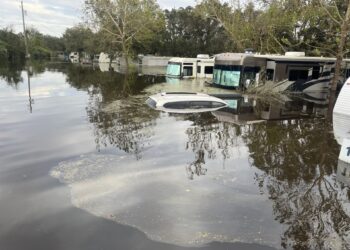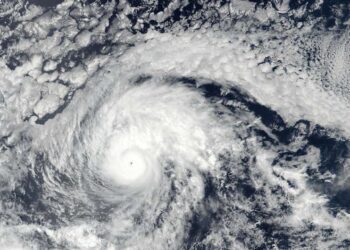Overview
Hurricane Helene struck the southeastern United States in late September 2024, leaving catastrophic destruction across Florida, North Carolina, Tennessee, and neighboring states. Making landfall in Florida’s Big Bend area as a powerful Category 4 storm, Helene caused extensive flooding, landslides, and storm surges, resulting in over 200 fatalities, the deadliest U.S. hurricane since Katrina. The storm’s devastation was particularly severe in Asheville, North Carolina, where power outages, road closures, and population displacement challenged emergency responders.
Our team produced a series of situation reports during and after Hurricane Helene, tracking changes in population densities and highlighting vulnerabilities in affected communities. These insights provided critical information to support recovery efforts.
Chronology of Population Dynamics and Displacement
September 30, 2024: Catastrophic Flooding and Displacement in Western North Carolina
Hurricane Helene’s impact on western North Carolina resulted in catastrophic flooding, landslides, and widespread property damage, leaving communities grappling with displacement and extensive disruption. With at least 138 fatalities reported across six states and hundreds still missing, the storm’s toll on the region was devastating. Asheville, one of the hardest-hit areas, faced severe accessibility challenges, with road closures limiting entry to emergency traffic only.
Power and Communication Outages
The storm caused widespread power and cellular network outages, leaving thousands without reliable communication or access to essential services. Vulnerable populations reliant on power-dependent medical devices were particularly at risk, with usage rates ranging from 0.029 to 0.044 per 100,000 residents in Buncombe, Spartanburg, and Greenville counties. These outages severely impacted the region’s ability to deliver aid and maintain healthcare services.
Population Displacement
Large-scale displacement significantly altered population densities in western North Carolina, with many residents fleeing to neighboring states for safety:
- Decreases in Population Densities:
- Buncombe County (including Asheville): -56% below baseline.
- Asheville: -52% below baseline.
- Fletcher: -44% below baseline.
- Lake Lure: -76% below baseline, reflecting one of the highest evacuation rates.
- Increases in Population Densities in South Carolina:
- Forest City: +39% above baseline.
- Boiling Springs: +31% above baseline.
- Hilltop: +25% above baseline.
- Easley and Greer: +21% above baseline.
Accessibility Challenges
Burnsville, located northeast of Asheville, faced unique challenges due to severe road damage. The town was impassable except by all-terrain vehicles, with population levels only -3% below baseline, suggesting that many residents were unable to evacuate despite the storm’s impact.
Takeaways
The displacement dynamics in western North Carolina and South Carolina underscore the importance of addressing accessibility and power reliability during disasters. The widespread population decreases in North Carolina highlight the scale of the evacuations, while the population surges in South Carolina towns emphasize the need for robust support systems in neighboring areas.
October 2, 2024: Impact and Recovery in Florida’s Big Bend Region
As of October 2, 2024, most communities in Florida’s Big Bend region were showing signs of recovery following Hurricane Helene, with population levels in many areas returning to baseline. However, some coastal communities continued to face challenges, reflecting ongoing recovery efforts and vulnerabilities.
Changes in Population Densities
Population data highlighted varied recovery trends across the region:
- Steinhatchee:
- Significant fluctuation in population densities, with daytime levels +10% above baseline and nighttime levels -10% below baseline. This pattern likely reflects relief efforts during the day and ongoing displacement at night.
- St. George Island and St. Marks:
- Populations remained below baseline, indicating slower recovery in these areas compared to other parts of the region.
Evacuations from coastal areas began on September 25 and stabilized by September 28, with most communities outside these vulnerable coastal areas returning to baseline population levels.
Community Vulnerabilities in Steinhatchee
Steinhatchee’s recovery remained particularly challenging due to its high percentage of elderly residents. With 54% of residents aged 65 or older, the town faced significant hurdles in addressing mobility, healthcare, and housing needs. These vulnerabilities compounded the ongoing recovery challenges following Hurricane Idalia the previous year.
Key Takeaways
The mixed recovery trends in Florida’s Big Bend region underscore the importance of continued support for vulnerable communities, particularly in coastal areas like Steinhatchee. These insights emphasize the need for targeted aid to address the unique challenges faced by elderly populations and towns with recurring storm impacts.
October 5, 2024: Gradual Recovery in Asheville, North Carolina
As of October 5, 2024, recovery efforts in Asheville, North Carolina, and the surrounding Buncombe County area were underway following the catastrophic impacts of Hurricane Helene. Despite widespread power outages affecting over 74,000 customers, disruptions to water systems, and delayed mobile network restoration, population levels showed a gradual return to pre-storm baselines. However, many challenges remained for vulnerable communities.
Changes in Population Densities
Population data revealed significant trends as Asheville worked toward recovery:
- Asheville: Population had recovered to 72% of the pre-storm baseline, with an estimated 67,000–69,000 residents remaining within city boundaries. However, many individuals were displaced to areas outside the city limits.
- Nearby Towns with Significant Population Decreases:
- Lake Lure, Hooper’s Creek, Montreat: Populations remained more than 50% below baseline with little day-to-day change.
- Population Increases in Buncombe County Towns:
- Marion and Salem: Populations surged +35% above baseline.
- Morganton: +25% above baseline.
- Valdese: +17% above baseline.
- Drexel: +15% above baseline.
Avery and Mitchell Counties, which experienced widespread damage, showed significantly higher population decreases than Buncombe County.
Medical Support and Community Resources
To address the needs of vulnerable populations, a medical shelter was established at 10 Genevive Cir in Asheville, providing critical support for residents reliant on power-dependent medical devices. This resource was vital in a region where ongoing power outages continued to affect access to essential medical care.
Data Reliability
In Avery County, the Facebook user base accounted for over 26% of the total Census population, ensuring high reliability of population movement data used to inform response efforts.
Key Takeaways
The gradual population recovery in Asheville highlights the resilience of the community, but the significant displacement to surrounding towns emphasizes the need for sustained support. Continued focus on power restoration, infrastructure repair, and medical resource access is essential to accelerate recovery and address vulnerabilities in both urban and rural areas.
Conclusion
Hurricane Helene’s devastation underscores the importance of real-time population data in disaster response. Understanding population dynamics allowed emergency responders to prioritize resources and address the needs of vulnerable communities effectively. Continued focus on data-driven strategies will be essential for mitigating future disasters.
Image Source: Florida Fish and Wildlife Conservation Commission



